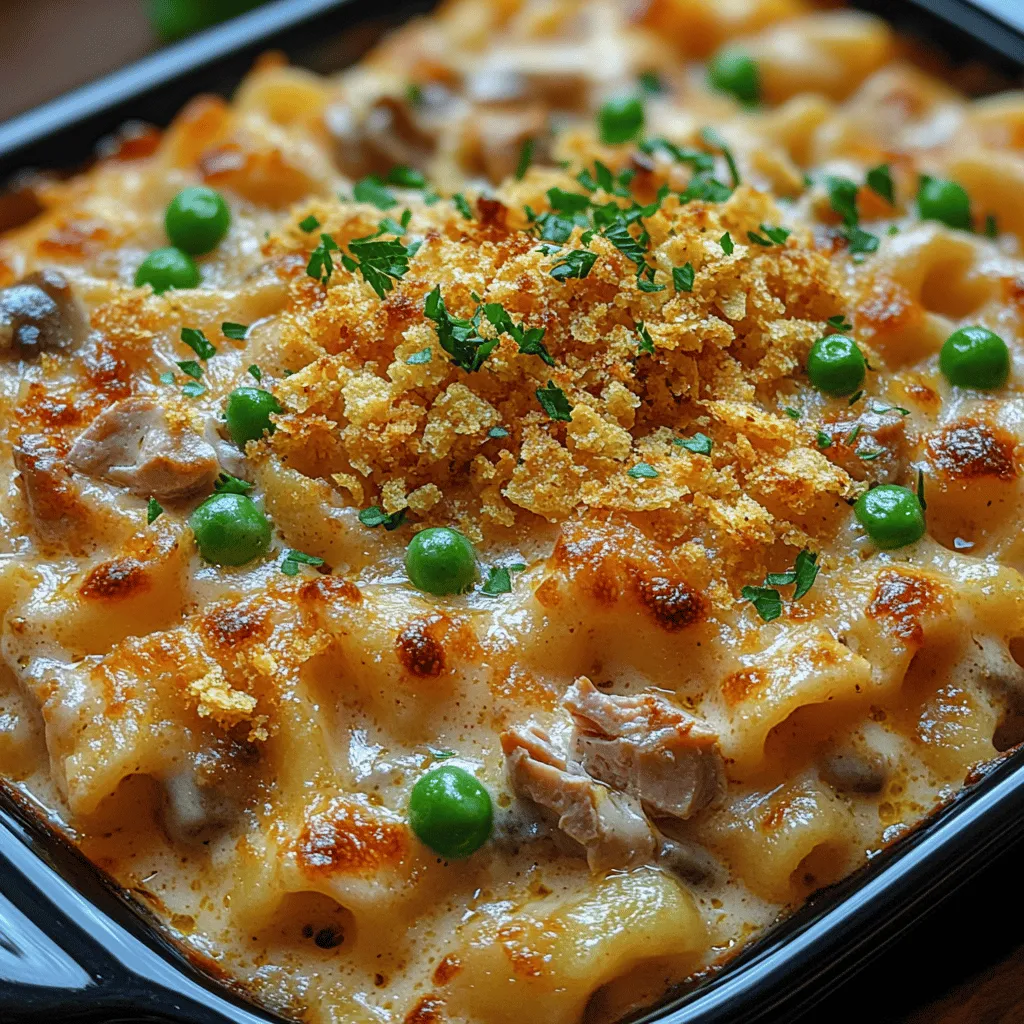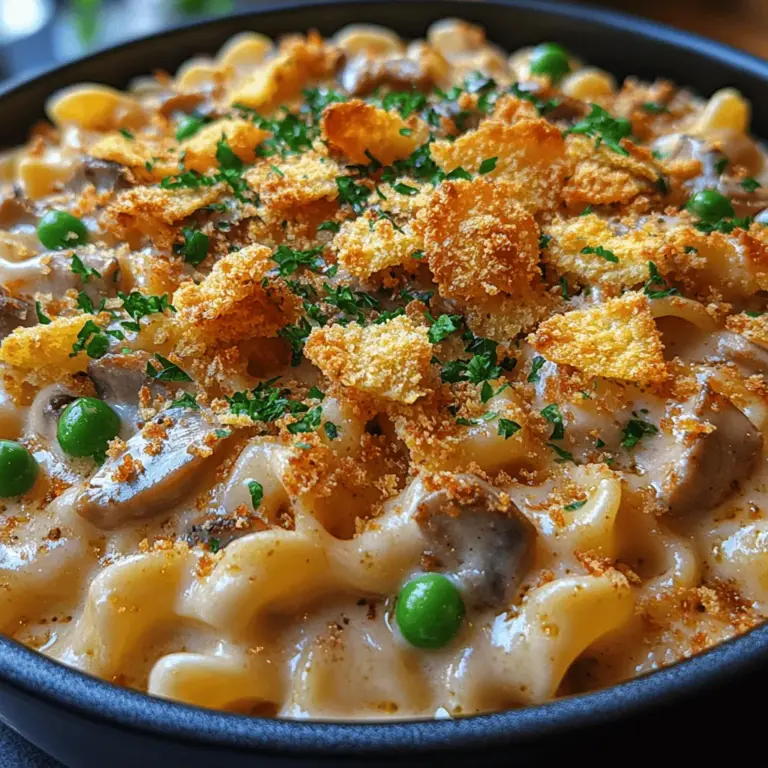Introduction
Tuna noodle casserole is a timeless dish that has graced family dinner tables for generations. This comforting meal combines the satisfying textures of tender egg noodles with the rich flavors of tuna, creamy sauce, and a delightful crunch on top. It’s a one-pot wonder that not only delights the palate but also warms the heart, making it a staple in many American households. The appeal of tuna noodle casserole lies not only in its delicious taste but also in its ease of preparation, affordability, and the ability to feed a crowd with minimal effort.
In addition to being incredibly tasty, tuna noodle casserole boasts a variety of nutritional benefits. Tuna is rich in high-quality protein, omega-3 fatty acids, and essential vitamins and minerals. Combined with other nutritious ingredients such as peas and onions, this casserole provides a well-rounded meal that can be both comforting and healthful. The dish is especially popular among busy families, college students, and anyone looking for a quick and filling dinner option. Its comforting nature makes it an ideal dish for potlucks, family gatherings, or simply a cozy night at home.
Comfort food plays a significant role in our lives, often evoking nostalgic memories of home-cooked meals shared with loved ones. Tuna noodle casserole is a quintessential comfort food that embodies warmth and familiarity, making it perfect for any occasion. Whether you’re trying to satisfy picky eaters or simply want a hassle-free recipe that everyone will love, this dish has your back.
Understanding Tuna Noodle Casserole
The history of tuna noodle casserole is deeply rooted in American cuisine, tracing its origins back to the mid-20th century. This dish emerged during a time when convenience and economy were paramount in American kitchens, particularly in the post-World War II era. Canned foods, such as tuna and cream of mushroom soup, gained popularity for their long shelf life and ease of preparation. As a result, recipes for tuna noodle casserole began to appear in cookbooks and on the dinner tables of families across the nation.
Over the years, the recipe for tuna noodle casserole has evolved significantly. While the classic version typically features canned tuna, egg noodles, cream of mushroom soup, and a crunchy topping, modern interpretations have introduced various twists. Home cooks have adapted the recipe to include fresh ingredients, alternative sauces, and diverse flavor profiles, catering to a wide range of dietary preferences. This adaptability has helped tuna noodle casserole maintain its status as a family favorite, with each generation adding their unique spin on the dish.
Despite the changes it has undergone, the fundamental appeal of tuna noodle casserole remains unchanged. It offers a comforting, hearty meal that can be prepared quickly and easily, making it an enduring choice for busy families. The combination of flavors, textures, and the nostalgic connection to the past ensures that this dish will continue to hold a special place in American kitchens for years to come.
Ingredients Breakdown
To create the perfect tuna noodle casserole, it’s essential to understand the role of each ingredient. Below is a detailed exploration of the key components that make this dish so delightful.
Egg Noodles
Egg noodles are the backbone of tuna noodle casserole, providing a soft base that absorbs the creamy sauce beautifully. Available in various sizes and shapes, they can range from wide noodles to thin strands. When choosing egg noodles, consider how they will cook and their texture in the final dish. For the best results, opt for medium-width egg noodles, as they strike a perfect balance between holding the sauce and providing bite. Cook them according to the package instructions until al dente, as they will continue to cook in the oven.
Tuna
Tuna is the star of this casserole, bringing a wealth of flavor and nutrition. When selecting tuna for your casserole, you have a few options: chunk light tuna, solid white tuna, or albacore tuna. Chunk light tuna is generally more affordable and has a milder flavor, while solid white and albacore tuna offer a firmer texture and richer taste. All types are packed with protein and heart-healthy omega-3 fatty acids, making tuna a nutritious choice for any meal. Look for tuna packed in water for a lighter option or oil for a richer flavor.
Cream of Mushroom Soup
Cream of mushroom soup adds creaminess and depth to the casserole. You can choose between canned options or make your own from scratch. Canned soups are convenient and save time, but homemade versions allow you to control the ingredients and create a fresher taste. If you’re opting for homemade, sauté fresh mushrooms and onions in butter, then stir in flour, broth, and cream to create a flavorful base. This allows you to customize the richness and seasoning to your preference.
Milk
Milk is another crucial ingredient that enhances the creaminess of the casserole. While traditional recipes often call for whole milk, you can substitute with lower-fat options or even non-dairy alternatives, such as almond milk or oat milk, for those with dietary restrictions. Keep in mind that the type of milk you use may slightly affect the flavor and texture of the final dish.
Peas
Peas add a pop of color and a burst of sweetness to the casserole. Fresh peas are delightful if in season, but frozen peas are an excellent alternative as they retain their nutritional value and are available year-round. Peas are rich in vitamins A, C, and K, as well as fiber, making them a healthy addition to the dish. Simply fold them into the casserole mixture before baking, allowing them to cook through and blend with the other flavors.
Onion and Garlic
Onions and garlic provide essential flavor enhancement to the casserole. Sautéing them beforehand helps release their natural sweetness and depth, which adds complexity to the dish. Yellow or white onions are commonly used, while garlic can be minced or sliced according to preference. A generous amount of both will ensure a well-seasoned casserole that is bursting with flavor.
Cheddar Cheese
Cheddar cheese is the perfect finishing touch for tuna noodle casserole, adding creaminess and a savory kick. You can choose from different types of cheddar, such as sharp, mild, or even smoked, to impart distinct flavors to the dish. Grating the cheese rather than using pre-packaged shredded cheese can result in better melting and a creamier texture. Layer cheese throughout the casserole and sprinkle some on top for a deliciously gooey finish.
Crunchy Toppings
To elevate the casserole’s texture, a crunchy topping is essential. Common options include crushed potato chips, breadcrumbs, or even crispy fried onions. Potato chips provide a salty, crispy contrast to the creamy casserole beneath, while breadcrumbs can be seasoned or mixed with melted butter for added richness. Choose the topping that best suits your flavor preferences and desired crunchiness.
Seasoning
The right seasonings can make all the difference in enhancing the flavors of your casserole. Thyme and paprika are classic choices that add warmth and depth, while salt and pepper are necessary for balancing flavors. Fresh herbs can also be incorporated for a more vibrant taste. Adjust the seasonings according to your palate and feel free to experiment with different herbs or spices to personalize your dish.
Preparation Steps for the Perfect Casserole
Creating a tantalizing tuna noodle casserole is a straightforward process that requires minimal effort. Here’s how to bring all these wonderful ingredients together into a delicious meal that your family will love.
1. Preheat the Oven: Start by preheating your oven to 350°F (175°C). This ensures that your casserole will cook evenly and thoroughly.
2. Cook the Egg Noodles: In a large pot, bring salted water to a boil. Add the egg noodles and cook until al dente, following the package instructions. Be careful not to overcook them, as they will continue to soften in the oven.
3. Sauté the Aromatics: While the noodles are cooking, heat a tablespoon of oil or butter in a skillet over medium heat. Add diced onions and minced garlic, sautéing until the onions are translucent and fragrant, about 3-4 minutes.
4. Mix the Casserole Ingredients: In a large mixing bowl, combine the drained tuna, sautéed onions and garlic, cream of mushroom soup, milk, peas, and half of the cheddar cheese. Stir gently to combine all the ingredients, ensuring the tuna is evenly distributed throughout the mixture.
5. Combine with Noodles: Once the egg noodles are cooked and drained, add them to the mixing bowl with the tuna mixture. Stir until everything is well combined, and the noodles are coated in the creamy sauce.
6. Transfer to Baking Dish: Pour the entire mixture into a greased 9×13-inch baking dish. Spread it out evenly, making sure to press down slightly to pack the ingredients together.
7. Add Toppings: Sprinkle the remaining cheddar cheese on top of the casserole. Then, add your choice of crunchy topping, whether it be crushed potato chips, breadcrumbs, or fried onions. This will create a delightful contrast in texture once baked.
8. Bake: Place the casserole in the preheated oven and bake for about 25-30 minutes, or until the cheese is melted and bubbly, and the top is golden brown.
Following these steps will ensure that your tuna noodle casserole is a delicious success, ready to be served to family and friends. With its rich flavors and comforting textures, this dish is sure to become a beloved favorite in your home just as it has for so many others.

Preheating the Oven
Preheating the oven is a crucial step in baking any dish, including our tantalizing tuna noodle casserole. It allows the oven to reach the desired temperature before the dish is placed inside, ensuring even cooking. When the casserole enters a preheated oven, the heat immediately begins to cook the ingredients, promoting proper texture and flavor development. If you skip this step, you risk uneven cooking, which could result in a mushy texture or ingredients that are overcooked on the outside but undercooked on the inside. Preheat your oven to 375°F (190°C) to ensure your casserole bakes perfectly.
Cooking the Noodles
Achieving the ideal al dente texture for your noodles is essential for the perfect tuna noodle casserole. Begin by bringing a large pot of salted water to a rolling boil. Adding salt not only enhances the flavor of the noodles but also helps in maintaining the desired texture. Once the water is boiling, add your egg noodles and cook for about 7 to 9 minutes, or until they are just tender but still firm to the bite. Remember that the noodles will continue to cook slightly in the oven, so it’s better to err on the side of undercooking them slightly. After draining the noodles, rinse them briefly under cold water to stop the cooking process and prevent them from sticking together.
Sautéing Aromatics
Aromatics play a pivotal role in elevating the flavor profile of your tuna noodle casserole. Start by heating a tablespoon of olive oil or butter in a large skillet over medium heat. When the oil is hot, add chopped onions, garlic, and any other desired vegetables such as bell peppers or celery. Sauté these ingredients for about 3 to 5 minutes, or until they become soft and translucent. This caramelization process enhances their natural sweetness and adds depth to the overall flavor of the casserole. Make sure to stir occasionally to prevent burning and ensure even cooking.
Mixing the Sauce
Creating the perfect sauce is instrumental in achieving the right consistency for your tuna noodle casserole. In a separate mixing bowl, combine a can of cream of mushroom soup (or a homemade equivalent), milk or cream, and a splash of lemon juice for brightness. The consistency should be creamy but not too thick; you want it to coat the noodles well without making the dish overly heavy. Whisk the mixture until smooth, then season with salt, pepper, and any additional herbs like dill or parsley for added flavor. This sauce not only binds the ingredients together but also adds moisture, ensuring your casserole remains deliciously creamy.
Combining Ingredients
Once the noodles are cooked, the aromatics sautéed, and the sauce mixed, it’s time to bring everything together. In a large mixing bowl, combine the cooked noodles, sautéed aromatics, drained tuna, and the sauce. Use a spatula or wooden spoon to gently fold the ingredients, ensuring an even distribution of flavors. Be careful not to over-mix, as this can break down the noodles and tuna. The goal is to have every bite infused with the rich and delectable flavors of the casserole.
Transfer to Dish
Properly transferring your casserole mixture to the baking dish is key to ensuring even cooking. Lightly grease a 9×13-inch baking dish with cooking spray or butter. Carefully pour the combined mixture into the dish, spreading it out evenly. Use a spatula to level the top, which will help it cook uniformly. For added texture and flavor, consider sprinkling a layer of breadcrumbs or crushed crackers on top before baking. This will create a delightful crunchy topping that contrasts nicely with the creamy filling.
Baking the Casserole to Perfection
Now, it’s time to bake your casserole to perfection. Place the dish in your preheated oven set at 375°F (190°C). Bake for about 25 to 30 minutes, or until the casserole is bubbly and heated through. You’ll know it’s done when the edges are slightly golden and the center is hot. A helpful tip is to insert a knife or toothpick into the center; if it comes out clean, the casserole is ready. To achieve that golden brown topping, consider broiling the casserole for the last 2 to 3 minutes of baking. Keep a close eye on it during this time, as broilers can quickly turn a perfect crust into burnt bits.
Serving Suggestions
Tuna noodle casserole is not only hearty but also versatile in terms of serving options. For a classic family-style presentation, serve the casserole directly from the baking dish at the dining table, allowing everyone to help themselves. Pair it with a simple green salad or steamed vegetables for a well-rounded meal. If you prefer individual portions, consider using ramekins or small baking dishes. This not only adds an elegant touch but also makes for easy serving and portion control.
When it comes to portion sizes, a typical serving is about one cup. However, this may vary based on individual appetites and accompanying dishes. Presentation can be enhanced by garnishing each serving with fresh herbs or a sprinkle of paprika for a pop of color. A dollop of sour cream or a slice of lemon on the side can also complement the flavors beautifully.
Nutritional Information
Understanding the nutritional profile of your tuna noodle casserole can help you make informed choices. A standard serving (approximately one cup) contains roughly 300-400 calories, with about 20 grams of protein, 10-15 grams of fat, and 30-40 grams of carbohydrates. The protein from the tuna and the carbohydrates from the pasta provide a satisfying meal that fuels the body effectively.
In addition to its comforting taste, this dish is packed with health benefits. Tuna is an excellent source of lean protein, omega-3 fatty acids, and essential vitamins and minerals. The inclusion of vegetables like peas, carrots, or spinach adds fiber, vitamins, and antioxidants, making this casserole a nutritious option for families. For those looking to modify the recipe for dietary preferences, consider using whole grain noodles for added fiber, low-fat or dairy-free alternatives for the sauce, or even adding more vegetables to boost the nutrient content.
Conclusion
Tuna noodle casserole embodies the essence of comfort food—delicious, satisfying, and easy to prepare. Its creamy texture and savory flavor make it a favorite among families, while its versatility allows for countless variations to suit any palate. As you gather around the table to enjoy this hearty meal, remember that food is not just about sustenance but also about creating memories. Sharing a homemade dish like tuna noodle casserole fosters connection and warmth, making it a staple in countless kitchens. Embrace the joy of cooking and the love that comes from sharing meals, and let this delightful casserole become a cherished part of your family’s dining tradition.

